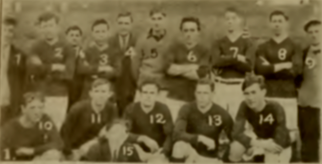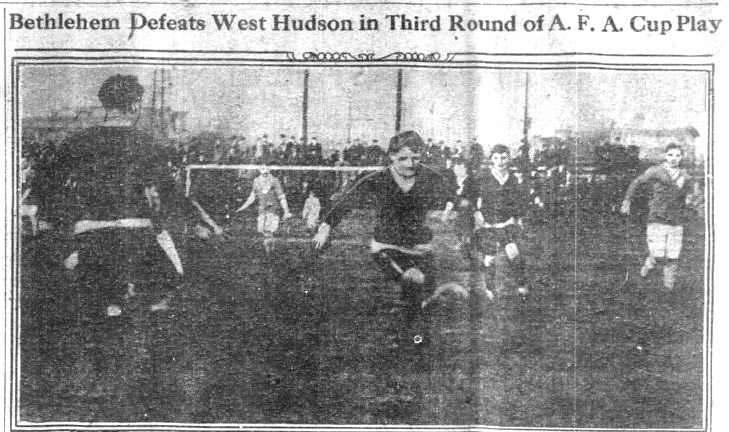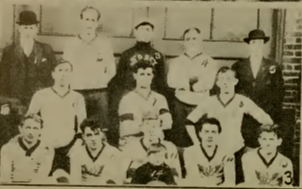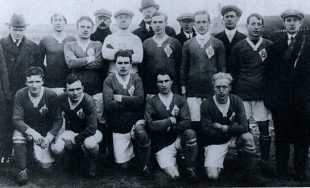Featured image: Courtesy Dan Morrison and bethlehemsteelsoccer.org
The 1913-14 season saw the launch of the National Challenge Cup, the competition now known as the US Open Cup, by the recently founded United States Football Association. While the National Challenge Cup would quickly become the singular competition for the title of Champion of the United States, the American Cup tournament had been founded in 1885 by the American Football Association, the first soccer governing body in America. The winner’s list of the American Cup was dominated by teams from New England, New York and northern New Jersey and much of the impetus behind the founding of the National Challenge Cup stemmed from the desire for a more nationally representative competition that would involve teams from as far west as Chicago, Detroit and St. Louis. Nevertheless, in 1913-14, the American Cup remained in the minds of many—at least on the East Coast—the competition for determining a national champion.
Philly in the American Cup
Tournament records are incomplete for much of the twenty years following the inaugural American Cup tournament in 1885 and it is unclear when Philadelphia teams first entered the competition. in 1897, the John A. Manz team became the first team from Philadelphia to win the American Cup. The first area team to enter the American Cup was the Trenton team in the second American Cup tournament in 1886 which lost in the first round. Trenton FBC made it as far as the semifinals in 1887 before being crushed by Clark ONT 5–0. A Trenton team entered the tournament in 1888 but forfeited before their first game. Trenton lost in the first round in 1889. That same year, Trenton Rovers played a scoreless draw with ONT but forfeited the replay. In the 1890 tournament, Trenton advanced as far as the semifinals where they were defeated 5–1 by Kearney Rovers.
Economic hard times played a role in the suspension of the tournament from 1899 through 1905, but local teams, such as Philadelphia Thistle in 1908, entered the tournament when it began again. The 1909-10 competition saw a record 29 teams enter the tournament with Philadelphia Corinthians, Philadelphia Hibernians, Philadelphia Thistle, Tacony FC and Camden FC all making it to the second round. Tacony would go on to win the Cup in 1910. Philadelphia Hibernian made it to what became a two-legged final in 1911 only to lose to Rhode Island’s Howard & Bullough. Four area teams made it to the second round in 1912-13 with Tacony appearing in a final that would be played over three games before Paterson True Blues emerged the winner. The 1913-14 tournament saw four area teams in the second round, Tacony FC, Philadelphia Hibernian, Victor FC of the Pennsylvania League and Bethlehem FC of the Allied American League. (A team called Victor Athletic also played in Philadelphia’s United League.) Three area teams were still alive in the semifinals.
The 1913-14 tournament would be plagued with poor weather and an astounding number of near epic replays. In the end, it would be Tacony facing Bethlehem in the final.
The soccer scene in 1913-14 Philly
The strength of the Philadelphia soccer scene was growing in the 1913-14 season with at least six leagues in operation. These included the Pennsylvania League, the Allied American League, the United League, the Cricket Club League, the Northeast League and the Junior League. Notices from unaffiliated teams in search of opponents for games regularly appeared in contemporary editions of the Philadelphia Inquirer as did announcements of exhibition games and inter-city match-ups such as the game between Philadelphia Hibernian and the then current American Cup holders Paterson True Blues on November 27, 1913. Hibs crushed the visitors, 5–1.
The season results for the Allied American League show three divisions containing 24 clubs. The Cricket Club League was strong enough to have two divisions. The reach of the first division of the Allied League extended outside of Philadelphia to include Bethlehem FC and Reading FC. The city’s Allied American Football Association had 35 member clubs that season and the association’s Allied Amateur Cup tournament drew 18 entrants. AAFA official Oliver Hemingway wrote in the 1914-15 Spalding Guide to Soccer Football, “The Allied American Foot Ball Association of Philadelphia again proved during the season of 1913-1914 that amateur soccer can be run and played better than by professionals in and around Philadelphia.”
While the standard of play varied among the city’s teams, the level of competition was fierce. Fights between players during games were not uncommon and referees often found themselves in difficult situations. Conflicts did not not stop with players on the pitch during game time. On October 26, 1913 the Philadelphia Inquirer reported that a match at Starr Garden Park between Glenwood Rovers and the Starr Garden team ended in a 1–0 win to the Rovers, “the spectators interfering at every stage of the game.” The report continued, “After the game was over 300 spectators started fighting with the Rovers and a riot call was sent in.” Such disturbances were apparently persistent enough for the Inquirer to suggest on March 30, 1914, “It would be a good idea for those who take an interest in the game in future to assist the referees as much as possible and at the same time protect the visiting players when leaving the grounds.”
While area soccer supporters were justifiably excited as the final rounds of the American Cup competition drew the eyes of the country’s soccer community to Philadelphia, that enthusiasm was not shared by local fans of other sports as match cancellations caused by poor weather, scheduling conflicts and cup replays caused the soccer season to stretch on into the spring. After wet weather caused the cancellation of a National League meeting between the Philadelphia Phillies and the Boston Braves, a comment on the editorial page of the May 7, 1914 edition of the Philadelphia Inquirer read, “No matter how bright the morning after a day of continuous rain, there always seems to be a hopeless void when we turn to the sporting page and have to read about soccer and other near-sports instead of a full account of the game that should have been played yesterday.”
While the backing of some Philadelphia newspaper writers may have been lacking, boosters in Bethlehem signaled their support of Bethlehem FC when they formed the Bethlehem Athletic Association soon after the start of the 1913-14 season. The Inquirer reported on November 27, 1913 that “local businessmen and Bethlehem Steel Works officials have undertaken to finance the trips that the club will be compelled to take out of town when drawn to play with other teams anywhere in this country.” Bethlehem was serious about their national aspirations.
Path to the Semifinals
American Cup play began easily enough for Tacony, who easily defeated Trenton Hibernians 3–1. That Tacony forfeited their opening round National Challenge Cup match against Kensington FC scheduled for the same day indicates the higher value some clubs placed on winning the American Cup title at that time. Higher value or not, the Inquirer noted on November 3, 1913, “There is something radically wrong in the arrangements when a team is scheduled to play two important cup games in one afternoon.”
First-time entrant Bethlehem trounced Wissinoming FC 5–1 in the preliminary round and advanced again after that when Trenton Caledonian forfeited their first round Cup tie with the Steelworkers. In other first round action for Pennsylvania District clubs, Philadelphia Hibernian crushed Smith FC 8–0, and Philadelphia’s Victor FC emerged the 3–2 winner over fellow Philadelphia side Boys’ Club, a team that would be better known as Lighthouse Boys’ Club.
In the second round of the Cup, Tacony continued their dominating form, dropping General Electric FC 4–1. Philadelphia Hibernian destroyed eventual finalists in the inaugural National Challenge Cup, Brooklyn Celtic, 7–1 and Victor steamed past Locomotive FC 4–1. Bethlehem traveled to Holyoke, MA to face the textile mill-sponsored Farr Alpaca FC team and returned to Pennsylvania the 3–1 winner.
Four Philadelphia-area teams were in the field of eight teams in the next round, the quarterfinals of the competition. Tacony brushed aside Brooklyn Field Club, eventual winners of the National Association Football League title, with a 3–2 win while Philadelphia Hibernian edged past the current American Cup holders Patterson True Blues with a 2–1 win. But for Victor FC and Bethlehem, it would take seven games to determine who would advance to the semifinals.
Victor had drawn Jersey City’s Jersey AC for the quarterfinals, playing them at Philadelphia Hibernian’s grounds at Third and Lehigh on December 27, 1913. After a scoreless first half dominated by Victors, the home team took a 1–0 lead 22 minutes into the second half. Soon after, Jersey tied and the match ended in a 1–1 draw. The replay in Jersey City on January 11, 1914 was scoreless after regulation time and remained so after extra time and so the series stayed tied at 1–1. The January 12 edition of the Philadelphia Inquirer reported that Jersey was close to scoring what would have been the winning tally three minutes into extra time with a one-on-one breakaway when the attacker to “fell down ignominiously” five yards from goal. The teams met again in Newark at the West Hudson Oval on January 25, 1914 and at the half Victor was leading 3–0. But a furious comeback was launched by Jersey and the score was tied at 3–3 with two minutes remaining in the match when Jersey scored to finish the game as 4–3 winners.
Bethlehem faced an even more difficult path to the semifinals against West Hudson AA, a three-time American Cup winner who had last won in 1912. Playing in Bethlehem on December 27, 1913 in front of 2,000 spectators on a field “covered with ice and snow,” the Inquirer reported on December 28 that the first half was “played at a terrific pace” but ended scoreless. Bethlehem took the lead 20 minutes into the second half when a corner kick glanced off of a West Hudson defender and into goal. Soon after, the Bethlehem goalkeeper made a stop on a shot from a breakaway but the visitors were able to convert the rebound and the game ended as a 1–1 draw.
A replay was scheduled for January 4 at the Harrison Oval in what the January 5 match report in the Inquirer described as “a storm of sleet, wind and rain and on a field heavy with mud and water.” Nevertheless, some 500 spectators were present. Bethlehem scored first six minutes into the first half but West Hudson equalized before the break. Twenty minutes into the second half, the referee called the game as the already unplayable conditions became even worse to force another replay. The two teams met again on the same grounds a week later and this time the weather was ideal. In front of 2,500 spectators, Bethlehem opened the scoring after 30 minutes of play only to concede the equalizer soon after. At the conclusion of regulation time the scoreline stood at 1–1 and remained so after extra time.
The fourth and final game of the series was held on neutral ground at Tacony Ballpark on February 1, 1914. The match was practically decided before the opening whistle when two West Hudson players missed the train to Philadelphia. With only one substitute on hand, the West Hudson goalkeeper was moved up front into the forward line, and the substitute placed between the posts, and the visitors played the entire match with ten men. The game started an hour late in a heavy downpour and the February 1 match report in the Inquirer reported, “As was to be expected, there was a great deal of roughness infused into the game and in consequence fouls were very frequent.” Before the end of the game, a Bethlehem player “received marching orders from the referee” after he kicked a West Hudson player “in a delicate place.” Bethlehem opened the scoring 12 minutes into the first half but West Hudson managed an equalizer 28 minutes later to send the teams into halftime level. In the second half, Bethlehem soon asserted themselves to finish the game 4–1 winners, 7–4 on aggregate, to advance to the semifinals.
The Semifinals
In the semifinals, Tacony drew Philadelphia Hibernian and Bethlehem drew Jersey AC.
Tacony hosted the Hibs at the Tacony Ballpark on March 21, 1914 in front of some 3,000 spectators. Hibs opened the scoring after a series of corner kicks finally resulted in a goal from eventual Hall of Famer Tommy Swords. Tacony equalized 18 minutes later and the score was tied at the half. In the second half, the Tacony offense proceeded to demolish the Hibs defense, taking the lead eight minutes after the resumption of play. Tacony soon added another goal from a penalty kick after a Hibs player handled the ball in the box. Not long after, Tacony made it 4–1. The Inquirer reported on March 22, “Never before in the history of the Hibernians have they been so completely outclassed as what took place in the second half of yesterday’s match,” adding “it is a question if any defense in the country could have successfully withstood the onslaught of the Tacony frontliners in the second half.”
Following the game, a report in the March 23 edition noted of Tacony’s honorable history in the American Cup tournament since winning the Cup in 1910, “those who are not well versed with their record during the five years will be surprised to know that every team which has eliminated the Taconys has won the Cup.” Bethlehem would have to get past Jersey AC in order to have the chance of keeping that particular record intact.
Bethlehem traveled to Jersey City to face Jersey AC on March 29 in their semifinal match and after going down two goals in the first half, Bethlehem battled back to to draw even at 2–2 before the final whistle for yet another a draw. By now, Philadelphia soccer fans were pulling for Bethlehem to emerge the winners “so that they will see them get a chance to tackle Tacony” and the Inquirer reported on April 2 “there is not the least doubt but that a large crowd from this city will journey to Bethlehem to witness the Bethlehemites in action.” Temporary stands were installed at Bethlehem’s grounds for the expected large crowd.
In the replay on April 4, Jersey took the lead after 27 minutes to take a 1–0 into the half. Bethlehem came out kicking in the second half and eventual Hall of Famer Whitey Fleming equalized in the 58th minute. Some 17 minutes later, Fleming put Bethlehem ahead with a long distance effort the Inquirer match report of April 5 described as “a magnificent goal with a long, hard shot.” Jersey kept battling, however and in the closing seconds of the game delivered a stinging effort that beat Bethlehem’s keeper “and only the post saved the game from going into extra periods in case of another tie.”
It would be Tacony against Bethlehem in the final of the 1913-14 American Cup.
The Final
The much anticipated final commenced on April 19 at Olympic Park in Patterson, NJ. It wasn’t much of a battle and ended in a 0–0 draw after regulation and extra time. The Inquirer match report on April 20 was scathing in its assessment of the game, describing “exceptionally weak” shooting,
The contest, which lasted exactly two hours, did not produce the class of football that one expected with such noted exponents of the game participating, and those who made the journey especially to witness the game were disappointed, for there was hardly five minutes’ good football during the whole game, Tacony being the team that showed the best combination, what little there was.
In a match with “too much fouling by both teams,” The Inquirer went on to criticize the referee, who “did not help matters any by pulling up for accidental fouls and allowing the ones that should have come under his optics to go by unnoticed,” including when the Bethlehem captain punched a Tacony player “on the jaw because the later had charged him with greater force than what suited the Bethlehem captain.” While noting that “a couple of schoolboy teams could have displayed better football,” the report continues,
Despite the fact that Bethlehem had made special preparations for this match by sojourning up in the Pocono Mountains since last Wednesday, they did not last as long as their opponents, though almost any untrained bunch of athletes could have gone today’s pace without in the least showing any signs of wear. The ground was lumpy nearly all over the field, which would have handicapped teamwork if either team had been guilty in that respect, while the seating facilities were inadequate for an important game…If time had been taken out every occasion that the ball went out of bounds, the referee would had to have taken off about one hour and a half of actual time for the ball was outside of the line more than it was in the field.
The need for yet another replay led to further grumblings on the Inquirer sports pages about the intrusion of the soccer season into the baseball season. On April 20, the Inquirer wrote, “as another game must be played the soccermen will still further invade upon the season belonging to the knights of the diamond.” Ahead of the replay on May 3, the Inquirer wrote on April 27, “If Tacony and Bethlehem repeat the same kind of football as was witnessed at Patterson when they battle again for the A.F.A. Cup next Sunday, it will be the death knell of soccer football for a while.” Not that Bethlehem was paying attention to such concerns; on April 25 they clinched the Allied American League title by defeating Smith FC 6-0.
 The win seemed to concentrate the efforts of Bethlehem, which included securing a special train so that some 500 supporters could travel to the replay in Newark. After 15 minutes of play, Bethlehem scored the game’s solitary goal to win their first American Cup championship. The Inquirer match report on May 4 concluded that Bethlehem deserved the win “for they infused more ‘pep’ into their game and made the most of their opportunities while the Taconyites did not take their chances,” but it was another ugly game. After 22 minutes of play, one Tacony player was deliberately kicked after winning the ball, falling heavily onto his left arm, “which hung limp at his side all through the game, though he was absent for about ten minutes after the injury,” this in the days before substitutions were allowed. The Inquirer match report continues, “While the game was better played then when the teams met two weeks ago, still it was such a rank exhibition of soccer on that occasion that it could have easily been improved, today’s game not being anything above the ordinary, as the players, at least some of them on both teams generally tried to get the man instead of the ball.”
The win seemed to concentrate the efforts of Bethlehem, which included securing a special train so that some 500 supporters could travel to the replay in Newark. After 15 minutes of play, Bethlehem scored the game’s solitary goal to win their first American Cup championship. The Inquirer match report on May 4 concluded that Bethlehem deserved the win “for they infused more ‘pep’ into their game and made the most of their opportunities while the Taconyites did not take their chances,” but it was another ugly game. After 22 minutes of play, one Tacony player was deliberately kicked after winning the ball, falling heavily onto his left arm, “which hung limp at his side all through the game, though he was absent for about ten minutes after the injury,” this in the days before substitutions were allowed. The Inquirer match report continues, “While the game was better played then when the teams met two weeks ago, still it was such a rank exhibition of soccer on that occasion that it could have easily been improved, today’s game not being anything above the ordinary, as the players, at least some of them on both teams generally tried to get the man instead of the ball.”
The league and American Cup championship now theirs, a headline in the May 4 edition of the Inquirer read, “Bethlehem Fans Going Dippy Over Winning Championships.” May 3 had also been the day that the Allied Amateur Cup final was to have been played between Bethlehem and West Philadelphia FC. When the game was rescheduled because of the American Cup final replay, West Philadelphia refused to play, claiming the match should have been held on the originally scheduled date, giving Bethlehem their third championship of the 1913-14 season. Bethlehem finished the season with only one loss out of 31 games played, that coming in the third round of the National Challenge Cup in a 1–0 loss to eventual Cup winners Brooklyn Field Club. With cup replays and poor weather causing postponements throughout the season, Bethlehem was at one point required to play three games in two days, winning all of them. Thirteen of the the games Bethlehem played in 1913-14 were shutouts and they outscored their opponents by the almost ridiculous total of 125 to 19.
The next season, Tacony would be taken over by the Disston Saw Company and would then play as the Disston FC. Bethlehem would leave the Allied American League to join the Philadelphia’s new American League where it would play the likes of Disston, Philadelphia Hibernian, Victor and West Philadelphia. While they would be knocked out of the American Cup with a semifinal loss to Brooklyn Celtic in 1915, Bethlehem would have their revenge a month-and-a-half later when they defeated Celtic in the 1914-15 National Challenge Cup final. Following that victory, Bethlehem would become officially backed by the Bethlehem Steel Company and would play as Bethlehem Steel.










Philadelphia has such a great soccer history. There should be a book.
Great work !
Visit the International Soccer Archives for more photos and memorabilia from Philadelphia and other soccer history.